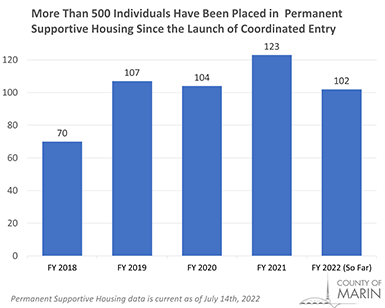San Rafael, CA — Marin County and its community partners have exceeded the milestone of housing over 500 formerly homeless individuals in permanent supportive housing since launching the Coordinated Entry system in October 2017. The count, as of August 10, stands at 518 housed.
 More than 500 individuals have been placed in permanent supportive housing since the launch of coordinated entry in late-October 2017.
More than 500 individuals have been placed in permanent supportive housing since the launch of coordinated entry in late-October 2017.
“The County is grateful to all its community partners, especially front-line case managers, for the incredible work they’ve done getting clients into housing including increasing the pace of housing by 56% since the beginning of the COVID-19 pandemic,” said Benita McLarin, Director of Marin County Health and Human Services (HHS).
People who are chronically homeless have been homeless for more than a year and have a disability that would make it difficult or impossible for them to live independently.
“I’ve seen people housed who were homeless for decades, who were homeless in the cities they grew up in,” said Christine Paquette, Executive Director of the nonprofit St. Vincent de Paul Society of Marin. “The impact of moving into housing after all that time is dramatic. Once a person has the safety and stability of housing, they can thrive.”
Coordinated Entry is a uniform system of assessment and prioritization to allocate housing resources. The purpose is to ensure that all people experiencing homelessness have fair and equal access to resources. Participants are identified, assessed for, and connected to available housing and homeless services based on their needs. The system uses standardized tools and practices, incorporates a system-wide Housing First (no barriers to entry) approach, and, in an environment of scarce resources, coordinates housing support to prioritize those with the most severe needs.
Mark Shotwell, Executive Director of Ritter Center, credits the collaboration of partners in the community for Marin’s success in getting people housed.
“When I came to Marin from Alameda County four years ago, the most striking thing to me was how well everyone worked together, from the County to the Housing Authority to the service providers," Shotwell said. "Everyone was unified in the goal of ending homelessness, not just for their clients but for everyone in Marin.”
The Future of Housing
While the 500-plus people housed represent a great milestone for Marin’s system of care and a life-changing intervention, many who need assistance are still waiting for resources.
“While our collective efforts have been successful in housing very vulnerable individuals and families in our community, we are reminded daily that housing is out of reach for many of our neighbors,” said Homeward Bound of Marin’s Mary Kay Sweeney. “Projects like Casa Buena in Corte Madera and Jonathan’s Place (formerly Mill Street) soon to open in San Rafael will end homelessness for many people. More projects like these are needed here and everywhere in the U.S. to finally level the housing playing field. We’re on our way!”
Marin County continues to invest in proven housing-focused solutions to homelessness, including over 100 new beds of housing through Project Homekey and housing-based case management paired with vouchers to create new supportive housing.
“We know that the solution to homelessness is a home,” said Gary Naja-Riese, Director of Marin HHS' Division of Homelessness and Whole Person Care. “We’re working hard every day until we have a home for everyone.”